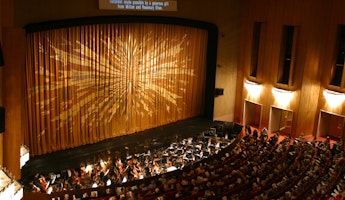Blog
October 17, 2023
The Acclaimed Director Behind "The Barber of Seville"
Director/choreographer Rob Ashford has a long list of distinguished Broadway credits, including Daniel Radcliffe’s star turn in How to Succeed in Business Without Really Trying and Cat on a Hot Tin Roof with Scarlett Johansson. He won a Tony Award for choreographing Thoroughly Modern Millie and he’s also got an Olivier Award, Emmy Award, Drama Desk Award and Outer Critics Circle Award to his credit. His 2014 staging of The Barber of Seville for Lyric Opera of Chicago was his first foray into opera, and this acclaimed production now serves as his introduction to Los Angeles audiences.
The premiere of this production at Lyric Opera of Chicago marked your eagerly awaited operatic debut. Are you a longtime opera fan or a more recent convert?
When I was in college in Pittsburgh, I danced in the corps de ballet at Pittsburgh Opera—that was my first taste of it. Then, when I moved to New York, one of my first jobs was dancing at the Metropolitan Opera for a year. My first show there was Hal Prince’s production of Faust. I feel as if my operatic education happened in the Met canteen, sitting with other dancers and seeing everyone in costume—that was where I felt I began to learn. Also, we could see anything we wanted. If I was having a rehearsal and we finished early, I’d go watch a stage rehearsal or a dress rehearsal. At that time in my life, it was less about the particular performances and much more about the scope. That’s what blew me away.
What drew you to The Barber of Seville as your first opera to direct?
Anthony Freud [general director of Lyric Opera of Chicago] had many interesting observations about why it would be a good fit. It might have been the fact of comedy being something we do a lot in musicals—understanding comic timing, the simplicity and focus of it. The focus on the stage in key moments was something Anthony felt I knew about from years of doing musicals—the idea of being able to focus on a small moment, inside a big tableau. You don’t have a camera, you’ve got a whole stage that’s alive, but you have to see the moment where the boy falls in love with the girl!
Barber is often played just for laughs. How do you bring humanity to it?
It’s a love story! Working with [scenic designer] Scott Pask and [costume designer] Catherine Zuber, the idea was that it should be romantic. The pure passion and the unabashed primary colors of Rosina and Count Almaviva’s love—or lust—for each other are what causes the comedy. People do silly things when they’re in love. I hope to find the humanity in the comic characters or, at least, to take them through that doorway of reality to find their humor.
Do you prepare for this the same way you prepare to direct a musical? (Other than the language being different.)
It’s all about the text—that’s the way I approach everything. If I’m going to do a play or musical, I focus on the text, what’s on the page, not other productions, and not “We’re going to do it differently from what so-and-so did,” and try to get to the essence of it.
I’ve directed Shakespeare—in a way, that’s a different language as well. I’m thrilled, actually, that I did Shakespeare before working with an Italian text. The meanings are so particular, that kind of research. I found it liberating to do Macbeth. It’s been the same with Barber—getting to the essence of what they’re saying, what the true translation is. I enjoy it, rather than feeling like it’s in the way.
How did the original Beaumarchais play help you?
He got it right! And Rossini based his opera on it, so it makes me trust the writing and not make me want to second-guess it. Because the play is so sound and Rossini’s work on top of that is so sound, it gives you an amazing freedom because you trust the material so much that you don’t question—you just try to bring it to life.
How do you expect the humor to emerge onstage?
From the situation these characters find themselves in.
How did you and Scott Pask go about conceiving your vision of Seville? What were your priorities?
I’ve been to Seville, and I know the Moorish influence there. I was keen to highlight the Spanish influence more. We have the beautiful tiles, the wrought iron, the grillwork, the gates—it feels traditionally Spanish.
How do you use your abilities as a choreographer in this piece?
When you have an idea for a dance and you make up some steps, you must put them on the dancer. And if the steps don’t suit the dancer, you need to change the steps. You want to make the dancer shines, so it would be crazy for me to choreograph a dance where the girl kicks only her right leg and her leg doesn’t look good kicking. When I direct, I have a basic idea of how everything should be, but I have to put it on them. And if it doesn’t suit them, I need to alter it, still getting to my point, still delivering my vision, but I’ve got to put it on them.
What’s your goal with this production?
I’d love it if people who know this piece say, “It was fresh. It wasn’t the same 20 gags that are always done”—that would be really exciting for me.
Our thanks to Lyric Opera of Chicago for this interview.



/terenceblanchard_hero.jpg?format=auto&fit=crop&w=226&h=140&crop=focalpoint&fp-y=0&auto=format&auto=format)




/03-cosi/_dsc0996_pr.jpg?format=auto&fit=crop&w=345&h=200&auto=format)









/terenceblanchard_hero.jpg?format=auto&fit=crop&w=372&h=380&crop=focalpoint&fp-y=0&auto=format&auto=format)




